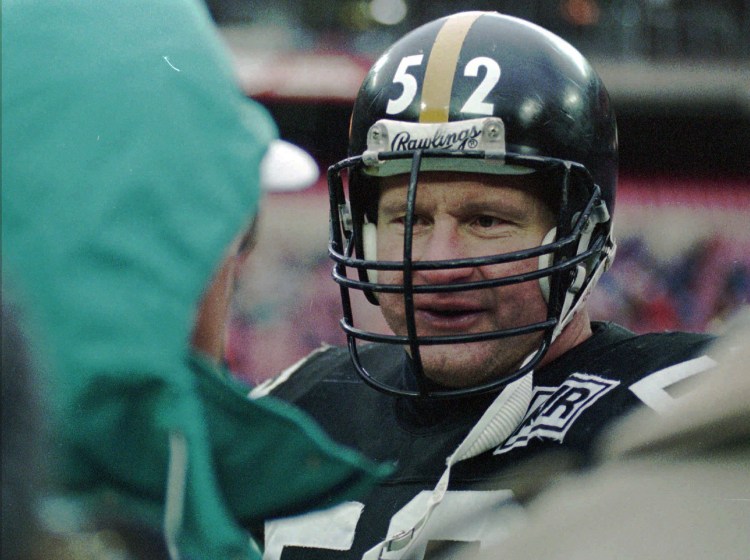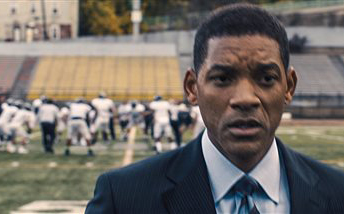ALEDO, Texas — A picture of Los Angeles Memorial Coliseum hangs in Walt Evans’ gym. Just above it is a picture of the great Pittsburgh Steelers offensive lines from the 1980s, with his friend, Mike Webster, in the center.
Evans and Webster ran every stair at every stadium they ever went to, and Los Angeles Memorial Coliseum always ranked as the most difficult. The steepness of the steps in the nosebleed sections is a killer.
But Evans fondly recalls those days he spent as the Pittsburgh Steelers’ strength and conditioning coach from 1982-88. He formed a bond with Webster by running stadium steps across the country, and saw firsthand the work put in by Webster, enshrined in the Pro Football Hall of Fame in 1997.
Those are the memories Evans likes to share about his time in football, and with Webster and the seven other Hall of Famers he trained. Those are the feel-good moments, and Evans proudly displays one of Webster’s Pro Bowl jerseys and Webster’s old helmet in his office.
But Evans knows Webster’s life has come to mean much more and could have a far greater impact on the game. In a cruel twist, Webster never fully enjoyed his post-playing career.
Instead he suffered from a debilitating brain disease known as chronic traumatic encephalopathy, or CTE, which has been directly linked to his football days and taking thousands of blows to the head. Webster’s sad story following his post-playing career is at the center of “Concussion,” Will Smith’s latest movie, which opens on Christmas Day.
Smith plays Dr. Bennet Omalu, the Nigerian pathologist who performed an autopsy on Webster and diagnosed him postmortem with CTE. The movie tells the story of Omalu, and his uphill battle in enlightening the NFL about the effects football has on the brain.
For Evans, now working in the Health, Safety and Environmental industry, it’s something that he believes Webster would want told and shared, no matter how heartbreaking. Webster committed suicide in 2002 at age 50.
“I think Mike would have been happy with the movie,” Evans said. “He was trying to show there was an issue (in his later years), something was wrong with his head or brain. And I think for everybody, this may be one of the greatest discoveries in sports medical history.
“How do you treat players with this disease? How do you prevent that from happening to current players? Everybody understands the seriousness of it now. I truly believe that Mike probably talked to Dr. Omalu and said, ‘Hey, find this.’ In the end this is a good thing.”
THOSE GRUELING DAYS
Nobody had longer minicamps or training camps than the Steelers under Coach Chuck Noll. It’s part of the reason the Steelers were the dominant team of the 1970s, winning four Super Bowls and remaining competitive into the 1980s.
Evans joined the Steelers’ coaching staff in 1982 and remembers the grueling practices. Two-a-days during training camp in the summer wasn’t out of the ordinary.
Nobody seemed to enjoy it more than Webster, a blue-collar guy who grew up on a farm in Wisconsin.
Back then, Evans said, practices were just as physical as the games. Nowadays, under new policies set forth by the NFL, teams essentially have glorified walk-throughs as practices with limited contact. Tackling drills are virtually non-existent.
The Dallas Cowboys, for instance, do not take teammates to the ground during their tackling drills.
In Webster’s era, though, it was different.
As Evans said, “We had hellacious practices. To play the game, you had to pay the price. But all those conditions over the period of time and in the game, takes its toll. Obviously.”
Not to mention that Webster became notorious for leading with his helmet. In fact, he had a specially made cushion in his helmet for extra padding, as he would lunge after the snap with his helmet and into the defender’s chest.
It’s a technique nobody questioned at the time, but in hindsight could have been a contributing factor to his CTE. In the film, Omalu estimates that Webster endured more than 70,000 blows to the head during 17 professional seasons.
Webster also could have played through multiple concussions, Evans said. During those days, players didn’t remove themselves with head injuries, particularly not someone known as “Iron Mike.” Webster played in 245 career games, starting every game he played from 1976-89.
“Mike always had this fear of failure, so his training and his mentality was intensely 100 percent and you’d see him play hurt all the time,” Evans said. “He never complained about an injury and he wouldn’t talk to anyone about injuries. That’s just the kind of guy he was.”
That drive and mindset is part of the reason Webster experienced so much success in the NFL, and put together one of the great offensive line careers.
A FIGHT WITH NO CURE
As “Concussion” vividly shows, life after the game wasn’t kind to Webster or others with CTE or brain-related injuries.
One side effect is depression, and these players who were once giants on the gridiron became different people.
In the film, which is based on Webster’s real-life story, he’s shown losing his teeth and using Super Glue to put them back.
Evans will never forget when he learned about Webster’s condition, and talking with legendary Steelers quarterback Terry Bradshaw about it.
“Bradshaw said, ‘He’s gone. Webby is gone,’ ” Evans said. “He’s just not the same guy we knew. He’s not the same Mike we knew and nobody knew what was going on.
“I talked with his wife and she said, ‘I don’t know. He has these emotional outbursts.’ It was just horrible. Horrible for his family, for his friends … he wasn’t the same guy.”
Webster’s teammate, Terry Long, dealt with a similar brain injury and took his life in 2005.
“These weren’t the same guys I knew when they were playing,” Evans said. “They were funny, jovial guys, and now we know why they changed so much.”
For former players, there is no pill or magical cure for CTE or brain-related injuries. Instead, it’s a difficult disease to live with and cure.
Some, like Webster and former San Diego Chargers great Junior Seau, get so frustrated that they take their own lives.
Former Cowboys running back Tony Dorsett is fighting that fight now, and has been diagnosed with signs of CTE.
There’s no easy way for them to deal with this disease.
Dr. Julian Bailes, a former Steelers doctor portrayed in “Concussion” helping Omalu with his theory, also weighed in on how former players dealing with CTE and brain-related injuries can avoid an outcome such as Webster’s.
“One of the big things that CTE sufferers have is depression,” Bailes said. “Many of them end up with alcohol or drug use and abuse. And probably half the time (their life ends) by suicide.
“So psychiatric evaluation, psychiatric care is a big part of trying to get ahead of the problem, I believe. There is no CTE medication.
“It’s been suggested that certain substances, which are natural brain antioxidants, may be beneficial – things like curcumin, Omega-3 fatty acids, resveratrol in red wine, green tea. These are all strong natural antioxidants and anti-inflammatory agents for the brain.”
THE SPORT’S FUTURE
The question now becomes what is the future of football.
Asked if Webster would have done it again, Evans said: “To a certain extent, yeah. But if he would have known about this, maybe he could have adjusted his game plan. He led with his head all the time … maybe he would alter that. You’re always going to have contact in football but you could adjust.
“And there were no strict protocols for concussions back in the day. It wasn’t as sophisticated as it is now. Athletes would always go in no matter what, even if they’re hurt, not even an inkling in their minds about what would happen (after their careers).”
That has changed in today’s game. Players such as former San Francisco linebacker Chris Borland have walked away from the game at a young age fearing brain trauma. Even Steelers quarterback Ben Roethlisberger, known for being gutsy and playing through pain, took himself out of a game earlier this season believing he had a concussion.
For Evans, a physiologist by trade, the importance is now figuring out how to best handle this issue going forward. He feels it’s important for parents of youth football players to understand the risks involved with the sport.
Evans said most brain development occurs between ages 5 and 12, and it doesn’t fully become mature until the mid-20s. So much like age limits for voting or driving or consuming alcohol, Evans believes there could be an age limit for contact football at some point.
Until, let’s say the eighth grade, children should only play flag football before putting on the helmet and pads.
“There are 148,000 high school concussions and 60,000-plus youth concussions, so we have to figure out where to start and what do we do to prevent this?” said Evans, who has yet to determine whether his 10-year-old son will play football.
“We need to make it safer while keeping the game still entertaining.
“I think the NFL owes it to those families – Mike Webster’s, Junior Seau’s, Terry Long’s – to be really dogged and help in a way so that this doesn’t happen to existing families.”
In “Concussion,” the NFL is painted as a power-hungry organization hell-bent on keeping the head-trauma issue under wraps. However, as Evans said, the league has taken extra measures in recent years to make it safer.
This past October in London, the NFL brought in representatives from many of the world’s sports leagues and leading concussion experts for the second annual International Professional Sports Concussion Research Think Tank to “share best practices and protocols and collaborate on ways to advance progress.”
Ideas from that conference have been brought to fruition, too. And the league has been active in making about 40 rule changes to try and avoid direct helmet-to-helmet collisions, adjustments to how teams practice and continued efforts to make a safer, better helmet.
Dr. Bailes has praised the advancement in the sport’s safety, and has no problem letting his two sons play football.
Bailes, now the chairman of the department of neurosurgery and co-director of the NorthShore Neurological Institute in Glenview, Illinois, called football “the greatest American sport” and called it “safer than ever.”
“There have been many steps taken in the last few years during this last decade of discovery which have made football safer,” Bailes said. “I think that football is safe as long as the players and their parents understand the risk, and the pros and cons and the benefits and potential risk of participating.
“However, it is still a contact sport. As we go, we will try to use what we’ve learned in brain trauma, as we help patients and people with brain diseases and brain problems.”
Copy the Story LinkSend questions/comments to the editors.




Success. Please wait for the page to reload. If the page does not reload within 5 seconds, please refresh the page.
Enter your email and password to access comments.
Hi, to comment on stories you must . This profile is in addition to your subscription and website login.
Already have a commenting profile? .
Invalid username/password.
Please check your email to confirm and complete your registration.
Only subscribers are eligible to post comments. Please subscribe or login first for digital access. Here’s why.
Use the form below to reset your password. When you've submitted your account email, we will send an email with a reset code.